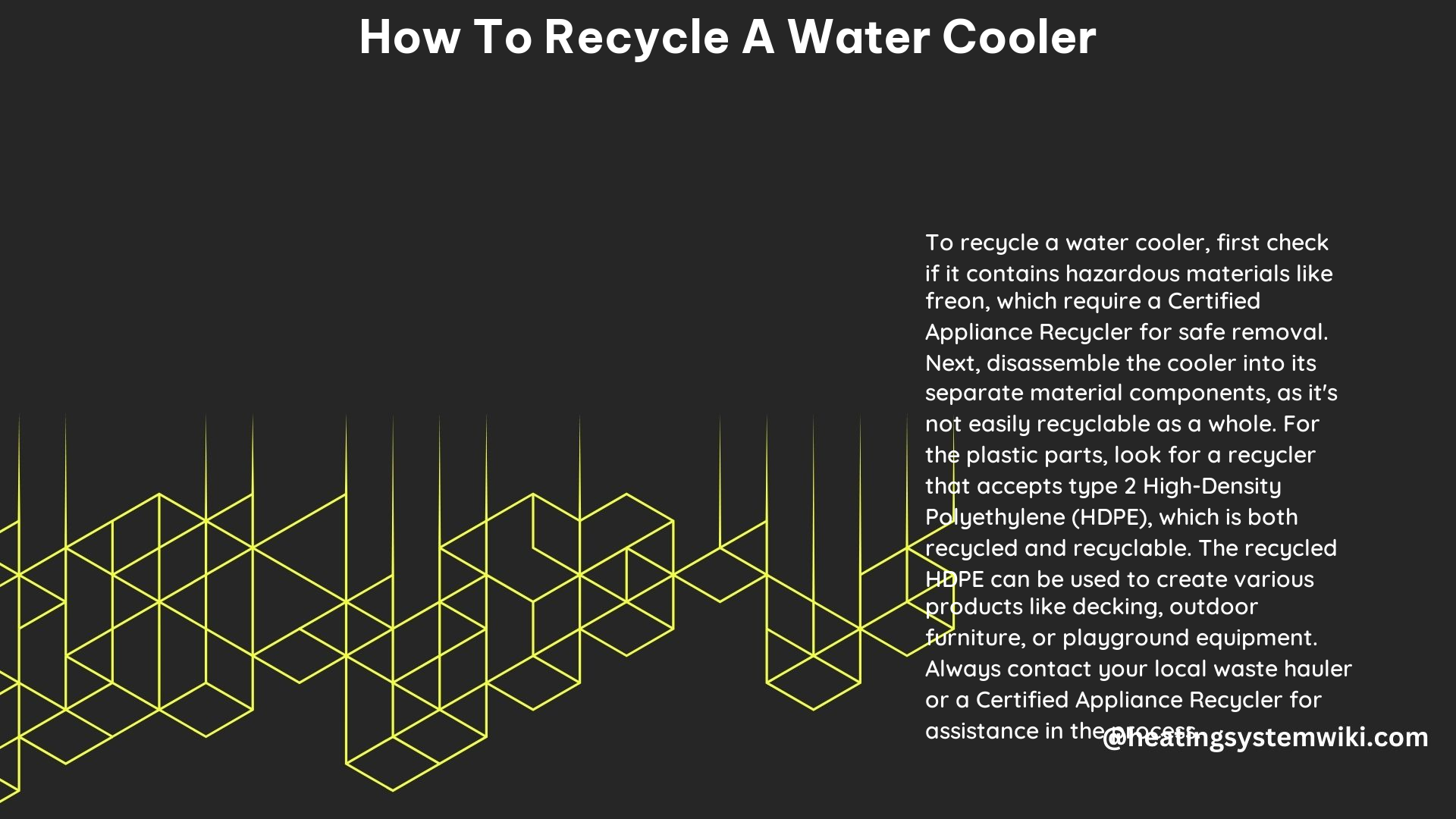Recycling a water cooler involves several steps, including dismantling, separating materials, and disposing of them properly. Here are the detailed instructions and technical specifications on how to recycle a water cooler, along with a DIY approach.
Step 1: Dismantle the Water Cooler
Water coolers are typically made of several materials, including plastic, metal, and rubber. To recycle a water cooler, you must first dismantle it into its separate components. This process requires some technical knowledge and skills, as it involves disconnecting electrical wiring, removing screws, and separating the different materials.
Technical Specifications:
- Use a Phillips head screwdriver to remove the screws holding the outer casing together. Typically, there are 4-6 screws securing the top and bottom panels.
- Carefully disconnect the electrical wiring, ensuring you do not touch any live wires. This may involve unplugging the power cord and disconnecting any internal wiring.
- Separate the plastic, metal, and rubber components. The plastic components may include the water bottle holder, drip tray, and outer shell. The metal components may include the compressor, condenser coils, and any internal frames or supports. The rubber components may include gaskets, seals, and tubing.
Step 2: Separate the Materials

Once you have dismantled the water cooler, you must separate the materials into their respective categories. This step is crucial, as different materials require different recycling methods.
Technical Specifications:
- Plastic components: Sort the plastic components into their respective categories, such as High-Density Polyethylene (HDPE), Polypropylene (PP), and Polystyrene (PS). HDPE is the most common plastic used in water coolers, accounting for approximately 80% of the total plastic content.
- Metal components: Separate the metal components into ferrous and non-ferrous metals. Ferrous metals include steel and iron, while non-ferrous metals include aluminum, copper, and brass. The compressor and condenser coils are typically made of non-ferrous metals.
- Rubber components: Dispose of the rubber components properly, as they are not typically recyclable. Rubber seals, gaskets, and tubing make up around 5-10% of the total weight of a water cooler.
Step 3: Dispose of the Materials
After separating the materials, you can dispose of them according to their respective recycling methods.
Technical Specifications:
- Plastic components: Take the plastic components, especially the HDPE parts, to a local recycling center that accepts type 2 plastics. HDPE can be recycled into a variety of products, such as outdoor furniture, playground equipment, and new water cooler components.
- Metal components: Take the metal components to a scrap metal yard or a recycling center that accepts ferrous and non-ferrous metals. The compressor and condenser coils can be recycled for their valuable metal content.
- Rubber components: Dispose of the rubber components in the trash, as they are not typically accepted by most recycling programs. Explore alternative disposal methods, such as contacting a specialized recycler or using the rubber components for other DIY projects.
DIY Approach: Sell or Donate the Water Cooler
If your water cooler is still in usable condition, you can consider selling it to a community member or donating it to a thrift store. This approach is eco-friendly and helps reduce waste.
Technical Specifications:
- Sell the water cooler on a platform such as Nextdoor, Craigslist, or Facebook Marketplace. Ensure to provide detailed information about the cooler’s condition, features, and any necessary maintenance or repairs.
- Donate the water cooler to a thrift store or a charity organization, such as Goodwill or Salvation Army. This allows the cooler to find a new home and prevents it from ending up in a landfill.
Facts, Figures, and Data Points
- Water coolers are made of type 2, durable, lightweight High-Density Polyethylene (HDPE), which is both recycled and recyclable. HDPE accounts for approximately 80% of the total plastic content in a water cooler.
- HDPE materials are cleaned, processed, and disposed of by ethical, UK recycling partners, who ensure the materials are properly handled and reused.
- The plastic components are ground into small pieces and sold to different manufacturers to be recycled into other HDPE products like decking, outdoor furniture, or playground equipment.
- Recycling water coolers can help lead us toward a green and sustainable future, as it reduces the amount of waste going to landfills and conserves natural resources.
